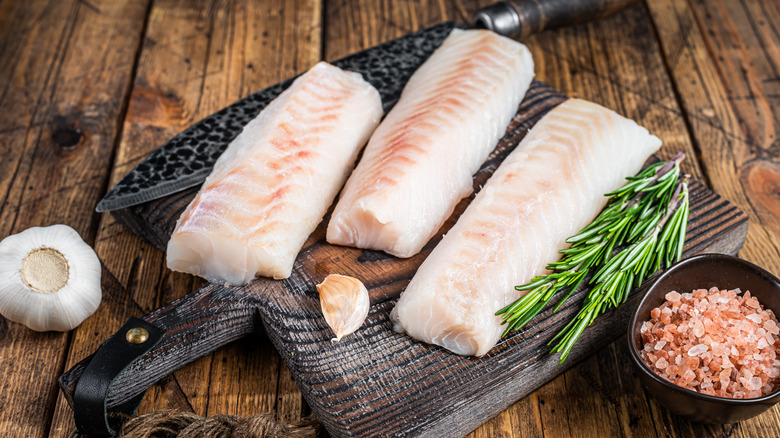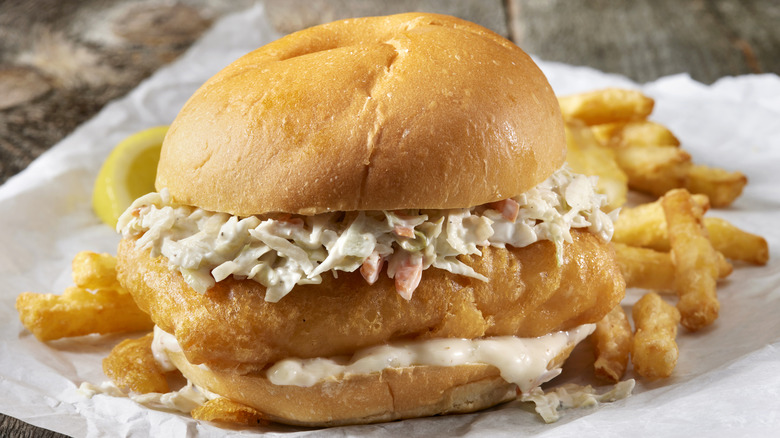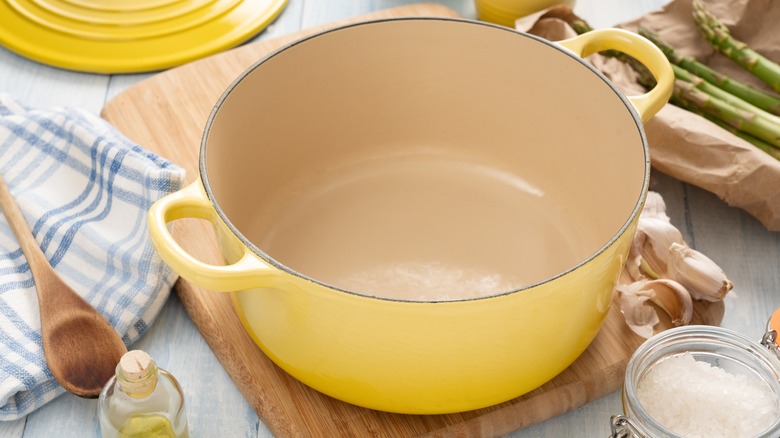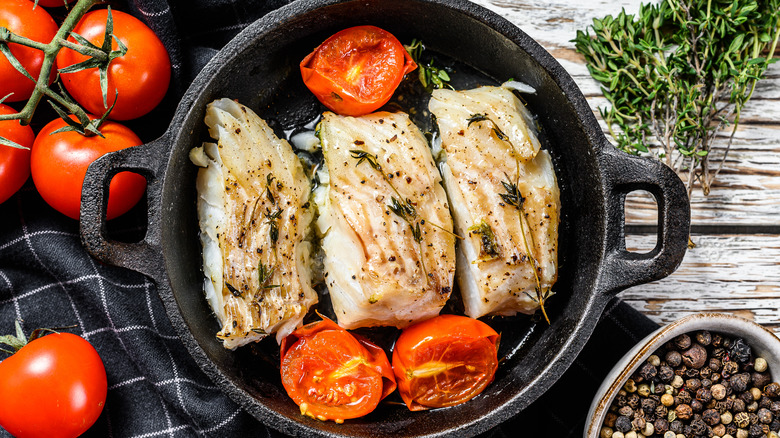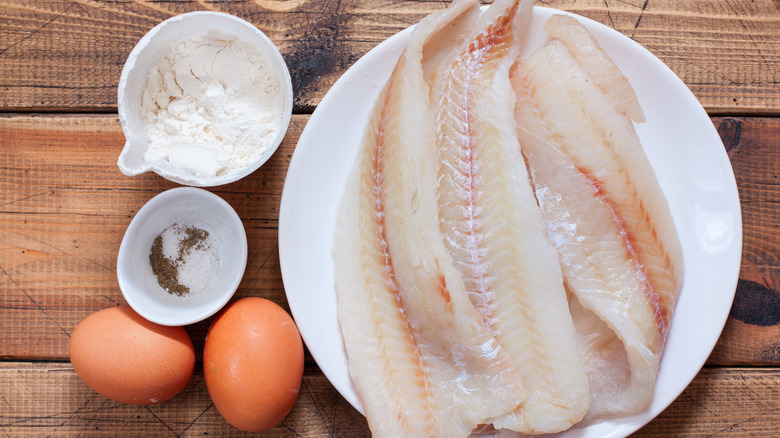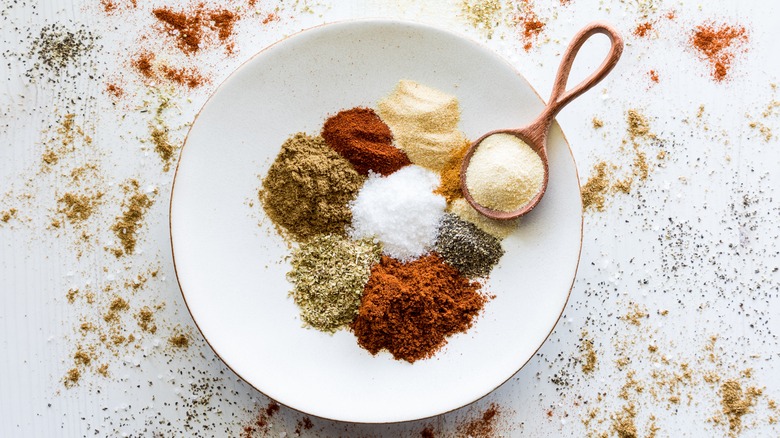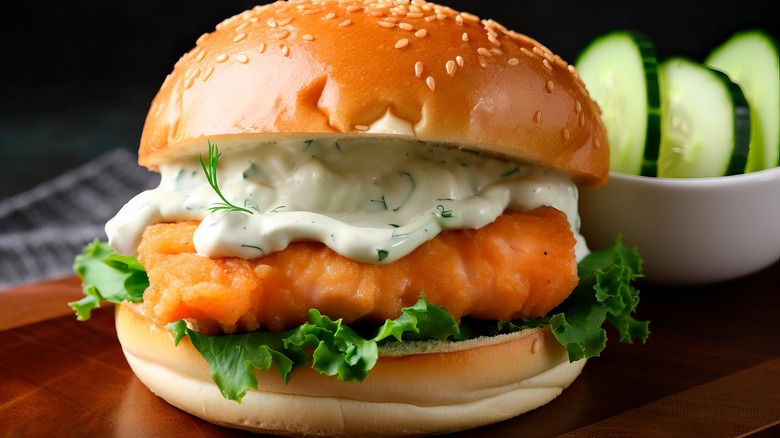14 Common Mistakes Everyone Makes When Cooking Fish Sandwiches At Home
When we make fast food classics at home, it's fish sandwiches every time. Fish sandwiches are often the butt of the joke in fast food restaurants, but there's a reason why more chains are including them on their menus. They provide a light alternative to heavier fast food choices while remaining satisfying, and with just a few ingredients, their sensory elements (the crispy fish, the soft bun, the creamy tartar sauce) are all the more noticeable and pleasing. Crucially, fish sandwiches also offer an alternative to meat during periods of religious observance like Lent.
If you can't find a fish sandwich in your favorite fast food restaurant, though, the good news is that making one at home is easy enough ... if you know what you're doing, that is. This simple-looking sandwich can be surprisingly easy to ruin, and by frying the fish in the wrong oil, using the wrong temperature, or cutting it to the wrong size, you can end up with a meal you'd rather throw out. Getting your seasoning wrong or using the wrong batter recipe, meanwhile, can make your fish sandwich tasteless and disappointing. Thankfully, with our tips, you needn't make any of those mistakes again.
1. Selecting the wrong variety of fish
So, it turns out that for a fish sandwich, you need fish. Who knew? More importantly, you need the right type — and not every variety will work here. Some types of fish, like salmon, have a richness and fattiness that doesn't work when battered or breaded and can overwhelm your fish sandwich. This is also the case with "fishier" fish like mackerel or herring, and cured or smoked fish styles. Other types, like sardines, are just way too small and somewhat pointless when battered and placed in a bun.
Instead, most of the time, you want a simple, no-nonsense white fish. Halibut and tilapia are both great choices, as they have subtle, unintrusive flavors and the perfect consistency to be battered. Cod, haddock, and pollock are also ideal for fish sandwiches, thanks to their flakiness and ability to cook quickly. If you want a slightly more robust flavor, catfish is also a superb option. Catfish has a gentle meatiness (almost a muddiness, really) that helps it to stand its own between your buns, and the sharpness of your tartar sauce can stop it from being the dominant flavor in the dish.
2. Forgetting to check your fish for bones
The last thing anyone wants when biting into a fish sandwich is a mouthful of bones. Unfortunately, that can be more common than you think when making one at home. Whereas fast food chains are pretty diligent about removing any bones from their battered fish, store-bought fish fillets can sometimes contain pin bones. These bones (which aren't actually bones at all but rather calcified ligaments) can quickly ruin your enjoyment of your meal.
Luckily, removing pin bones from fish fillets is a simple, quick job. You start by laying your fish fillet flat and running your fingers across the top gently, to identify where they are. Once you've found the bones, just take a pair of tweezers or pliers and pull them out, making sure not to rip the flesh as you do so. Repeat until you've gotten rid of all the bones. Importantly, not every fish fillet will have pin bones, though they may be more likely to be there if you've bought them from a fishmonger. If you don't find any after a thorough search, don't panic that you've missed them.
3. Picking a fillet that's too large
No one wants a fish sandwich that has a tiny, scrappy, barely visible battered fillet inside. However, it's all about balance. If you opt for a fish fillet that's too large, your meal will be less of a sandwich and more of a piece of fish with two sides of a bun clinging to it desperately. The meal will be unwieldy and difficult to pick up and lack the correct ratio of bread, sauce, and fish. Picking a fillet that's too large can also throw your cooking times out of whack, leading to undercooked (or overcooked) fish.
So, make sure you're using a fillet that's the right size. As a rough guide, a square or rectangular piece of fish weighing roughly 4 ounces is a good benchmark. Naturally, though, this weight won't work for every purpose, and if you're making small pollock sliders or larger sandwiches, you may need more or less. Arguably the best way to figure out how much you need, and what size fillet is right for you, is to start with the bread you're using and work from there.
4. Picking the wrong oil to fry your fish in
The items that end up in your fish sandwich are not the only ingredients you need to think about when making it. You also have to consider the oil you'll use to cook your fish — and picking the wrong one can be a big mistake. Oils with low smoke points may not be able to handle the high temperatures required for deep-frying fish successfully. As a result, the oil can break down, releasing acrid flavors and smells into your fish and your home. Flavored oils, meanwhile, can give your fish a strange taste you didn't want.
Your best bet is a neutral-flavored oil with a high smoke point. Peanut oil is a particularly good choice here: It has a smoke point of 450 degrees Fahrenheit and a neutral flavor, and it also won't break the bank. Canola oil is another good choice, and while it has a slightly lower smoke point, you're unlikely to exceed its upper limit of 400 degrees Fahrenheit. Canola oil is also widely available and within most people's budgets. If you have coconut oil at hand, that can also work, but remember that this can cost more than other oils, and you'll need a fair amount to deep-fry your fish.
5. Using the wrong pan for deep-frying
You might not think that your choice of pan makes a big difference when cooking fish sandwiches — but it does, y'all. Deep-frying at home can be pretty intimidating, and trying to do it with a skillet or a shallow pan will make it even more so. When you use a pan that doesn't have adequate depth, you're at constant risk of oil spilling out over the edges. You also prevent your fish from being cooked properly on each side, as it'll likely rest on the bottom of the pan, instead of being able to bob around in it.
Rather than risk a lot of mess and a potential injury, grab yourself the right vessel. Opt for a high-sided pot, with enough depth to take a few quarts of oil while still having a good amount of space at the top. It's always best to go for a heavy-bottomed pot when deep-frying, as this reduces the risk of both small spillages and the pot spilling if it's unintentionally knocked. Heavy-bottomed pots, like cast-iron Dutch ovens, will also retain heat more effectively, reducing the risk of your oil's temperature dropping suddenly.
6. Moving your fish around too much when pan-frying
Not every fish sandwich uses a deep-fried fillet. Whether you're going for a breaded fish piece or a naked one, you can achieve excellent results by pan-frying it. However, treating your fish right when you're pan-frying it is key to getting the best result, and moving it around too much can quickly destroy your fillet. Fish flesh is supremely delicate, and every time you prod or shift it, you risk it breaking or tearing. This is way more likely to happen early on in the cooking process, when the fish may not have seared enough to flip successfully, but it can happen at any point.
The best thing to do is to try to move your fish as little as possible. Once you place it in the pan, leave it to sizzle for three to four minutes, until its surface (or your breading) has gone golden and crispy. Then, to assess whether it's ready to flip, wiggle your pan. If your fish releases from the bottom easily, it'll be fine to turn over. If it's still adhered to the bottom, it may need a bit more time to crisp up.
7. Not checking your cooking time
Frying fish feels like one of those things you can kind of just guess — but you shouldn't. If you don't figure out how long your fish will take once it hits the oil, you risk two things happening: the batter burning and your fish overcooking. When your batter burns, it'll go dark brown and develop a pungent, bitter flavor. Overcooked fish, meanwhile, will go dry and mealy.
All of this can be easily avoided by figuring out how long you need to cook your fish. At 350 degrees Fahrenheit, your fish should cook in around eight to 10 minutes. It's always best to flip it over at least once during the cooking process, so it cooks evenly. If your oil is slightly hotter, it will naturally take a bit less time, but aiming for 350 degrees is a good starting point — buying a clip-on thermometer for your pan is always a good idea. If your fry oil's too hot, there's a simple hack to fix it: Just add more.
Speaking of thermometers, when your fish is done, insert one into the thickest part of your fish (inserting it in a place that won't ruin its batter coating). If it reads at 140 degrees Fahrenheit, you should be good to go.
8. Using the wrong type of batter
We'd take an unbattered fillet over a poorly battered one any day of the week. When batter goes wrong, it goes wrong, and it can quickly become tasteless, gloopy, or heavy. While this can happen for many reasons, one of the main ones is if your batter contains too much flour, which can cause it to thicken up and get cake-like.
You can counteract this by making sure your ratios are on point and making a batter that's moist enough to remain light. One of our favorite ways to do this is to not just use water but throw beer in, too. What the beer in beer batter actually does is introduce carbon dioxide, keeping the batter light and crispy. The alcohol in beer also helps the batter's moisture evaporate more quickly, allowing the batter to get super-crunchy. On top of all that, beer gives your batter a hint of maltiness and a slightly deeper color, intensifying your culinary experience.
9. Picking the wrong bread for your sandwich
A fish sandwich lives and dies by the kind of bread you choose, and opting for the wrong one is a quick way to ruin your hard work. Size, texture, and flavor are all factors you need to keep in mind. You want your bread to act as a soft contrast to your crunchy battered fillet, so crusty bread, baguettes, and hard rolls are usually best avoided. A little sweetness can work excellently with the salty fish, but overly sweet options can be distracting. You also want to make sure that your bread pieces aren't too big or too small, as it'll ruin your fish-to-bread ratio.
The optimal choice is a mid-size, gently sweet soft roll, small enough to hold in your hand but big enough to be satisfying. A standard hamburger bun is always a reliable option, but if you want something a little sweeter, a brioche bun is also a great choice. The buttery, gently sweet flavor of the brioche works wonders with the crunchy, fatty fillet. If you're looking for something a bit more robust, a Kaiser roll can also work brilliantly. Just make sure you don't pick up one that's too hard, so your battered fish can shine through in all its crispy glory.
10. Forgetting to season your fish
There are few crimes against cooking more heinous than an unseasoned piece of fried fish. Without the adequate level of seasoning, your fish fillet will lack flavor — most fish varieties that work well in fish sandwiches are mildly flavored and need a good amount of salt, pepper, and other seasonings to bring them to life. Failing to season it properly will make the fish both bland and unbalanced, as there'll be nothing to counteract the fats absorbed by your batter or breading, and everything will end up tasting pretty oily.
If you're battering your fish, you should always add a good amount of seasoning to your mixture. Salt is, of course, a must, but don't neglect other seasonings, like onion or garlic powder, which can help to round out the flavors and give some important savory notes. If you're going for a breaded fillet, make sure you mix in some dry seasonings. This is an awesome opportunity to get creative with your flavors: Some Old Bay or a sesame-ginger seasoning blend can bring unexpected life to your fish sandwich. If you've neglected to add salt or seasonings into your batter or breading mixture, though, never fear — give your cooked fillet a light sprinkling of salt when it's still warm.
11. Not draining your fish pieces before making your sandwich
Deep-frying a fish fillet to crispy perfection is a skill that all fish sandwich lovers should master. However, if you're not draining your fish pieces after you pull them out of the fryer, all of that hard-earned expertise will be for nothing. If you forget to drain your fish pieces, they'll carry excess oil into your sandwich. This oil will then soak into your bread and turn your sandwich into a greasy, gloopy mess.
So, before you pop your fish in your sandwich, give it a minute for its oil to drain. Don't worry about it going cold here: As it's cooked at such a high temperature, it will retain its heat for a good few minutes (and in reality, you'll probably want to give it a minute to cool down, so you don't burn your tongue). The easiest way to drain your fillet to place it onto some paper towels. The paper will soak up all of that excess fat quickly, leaving the fish crispy and light-tasting. You can also place your fish pieces onto a wire cooling rack, allowing the fat to drip off before serving.
12. Messing up your condiments
Condiments are everything in a fish sandwich and give your meal a much-needed pop of flavor and a necessary contrast to the other taste and texture elements. Picking the wrong ones, however, can ruin it. Barbecue sauce, for example, may work in other sandwiches, but when paired with fish, it can be a bit overpowering and add too much sweetness into the mix. Salsa is also a big no-no for us: There's something about it that just doesn't meld with the combination of fish and white bread, and things can get a little cloying.
While many condiments do work with fish sandwiches, we would always recommend tartar sauce first. Its combination of mayo, capers, pickles, and mustard gives it the perfect balance of creaminess and tartness, which complements the fish wonderfully. It's also a breeze to whip up, and homemade tartar sauce is much cheaper than the store-bought version. If you don't have the energy to make tartar sauce, it's hard to go wrong with a spread of mayo and a pop of mustard. Tomato ketchup may not be to everyone's taste, but we find that it provides a fish sandwich with a useful burst of tanginess.
13. Leaving your greens wet
Greens aren't mandatory in a fish sandwich, and many recipes opt to leave them out entirely. In our view, however, they're a worthwhile addition. Greens like lettuce or spinach give your fish sandwich a juicy crunch and a slightly grassy taste that cuts through the otherwise salty, fatty notes. They also make your fish sandwich feel that much more wholesome, which is never something we object to.
Unfortunately, however, how successful your greens are in your sandwich depends entirely on how you prepare them, and leaving them wet is a depressingly common occurrence. If you don't dry your salad greens after you wash them, they retain a surprising amount of surface water, which then transfers into your sandwich, making your batter and your bread wet. In mere moments, your sandwich can get astonishingly soggy.
Spinning your salad greens is a good move before putting them in your sandwich, but this can only dry them so much. As an extra step, we recommend laying them out on some paper towels after spinning them and leaving them to air-dry for a while. If you don't have the time to do this, lightly pat them down with the towels and then throw them in your sandwich.
14. Layering your sandwich incorrectly
Putting a fish sandwich together is an art form, and the order you layer everything has a big impact on your eating experience. If you put your cheese in the wrong place, place your lettuce on too early, or put your condiments somewhere strange, you affect your sandwich's texture fairly significantly.
As a general rule, remember that salad greens or crunchy veggies like pickles should go at the top. This stops your fish fillet from skidding off a wet piece of lettuce placed on the bottom bun. Cheese, meanwhile, should go on top of your fish fillet when it's still hot. Although certain fast food fish sandwiches have their cheese on the bottom bun (like the McDonald's Filet-O-Fish), we think putting cheese higher up allows it to soften, melt slightly, and drape itself over the fish. As for condiments, ensure that you're spreading them on each bun and not squirting them onto your fish. This reduces the likelihood of them pooling or squirting out when you bite into the sandwich.

